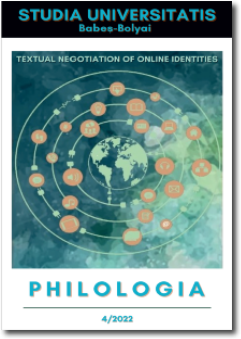IDEOLOGIZED IDENTITIES IN THE ROMANIAN E-NEWS. A CULTURAL SOCIOLINGUISTIC QUERY OF CONVERGED MEDIA TEXTS ON THE 2022 RUSSIA-UKRAINE CONFLICT
IDEOLOGIZED IDENTITIES IN THE ROMANIAN E-NEWS. A CULTURAL SOCIOLINGUISTIC QUERY OF CONVERGED MEDIA TEXTS ON THE 2022 RUSSIA-UKRAINE CONFLICT
Author(s): Diana CotrăuSubject(s): Media studies, Sociolinguistics, Cultural Anthropology / Ethnology, ICT Information and Communications Technologies, Russian Aggression against Ukraine
Published by: Studia Universitatis Babes-Bolyai
Keywords: Cultural Sociolinguistics; Ethnography of Netspeak; ideologized identity; digital cultural practices; textual interpretation; e-Press; Social Networked Sites;
Summary/Abstract: Ideologized Identities in the Romanian e-News. A Cultural Sociolinguistic Query of Converged Media Texts on the 2022 Russia-Ukraine Conflict. The design for this paper is to provide a qualitative analysis of how positioning towards the two parties directly involved in the 2022 Russia-Ukraine conflict has been the catalyst of the textual morphing of two ideologized identities in some of the Romanian e-Press. The focus was on the locus of convergence of two types of mediated texts: the production of professional press editors and journalists, and of Social Networked Sites users and prosumers. With this intent, the Romanian HotNews.ro website was scrutinized, and a number of e-news items were singled out thematically and structurally. The presumption is that the mediation process has been conducive to foregrounding two ballpark antithetic identities as underpinned by correspondent ideologies. An interdisciplinary perspective was opted for, one that joins Cultural Sociolinguistics and Critical Discourse Analysis (Agha 2007; Androutsopoulous 2006; Blommaert 2017; Herring 2013; Silverstein 2004; Thurlow 2017; Wodak 2022) with the Ethnography of Netspeak (Kozinets 2010; Markham 2016, 2020; Zappavigna 2011) and focuses on collective identities in order to diagnose how the mediated text, as part of the semiotic architecture of the said e-Press inputs, pairs up antithetic ideology-determined identities in times of crisis.
Journal: Studia Universitatis Babes-Bolyai - Philologia
- Issue Year: 67/2022
- Issue No: 4
- Page Range: 85-104
- Page Count: 20
- Language: English

